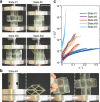A three-dimensional actuated origami-inspired transformable metamaterial with multiple degrees of freedom
- PMID: 26965475
- PMCID: PMC4793042
- DOI: 10.1038/ncomms10929
A three-dimensional actuated origami-inspired transformable metamaterial with multiple degrees of freedom
Abstract
Reconfigurable devices, whose shape can be drastically altered, are central to expandable shelters, deployable space structures, reversible encapsulation systems and medical tools and robots. All these applications require structures whose shape can be actively controlled, both for deployment and to conform to the surrounding environment. While most current reconfigurable designs are application specific, here we present a mechanical metamaterial with tunable shape, volume and stiffness. Our approach exploits a simple modular origami-like design consisting of rigid faces and hinges, which are connected to form a periodic structure consisting of extruded cubes. We show both analytically and experimentally that the transformable metamaterial has three degrees of freedom, which can be actively deformed into numerous specific shapes through embedded actuation. The proposed metamaterial can be used to realize transformable structures with arbitrary architectures, highlighting a robust strategy for the design of reconfigurable devices over a wide range of length scales.
Figures





References
-
- Martinez R. V., Fish C. R., Chen X. & Whitesides G. M. Elastomeric origami: programmable paper-elastomer composites as pneumatic actuators. Adv. Funct. Mater. 22, 1376–1384 (2012).
-
- Wei Z. Y., Guo Z. V., Dudte L., Liang H. Y. & Mahadevan L. Geometric mechanics of periodic pleated origami. Physical Review Letters 110, 215501 (2013). - PubMed
-
- Felton S., Tolley M., Demaine E., Rus D. & Wood R. A method for building self-folding machines. Science 345, 644–646 (2014). - PubMed
Publication types
MeSH terms
Substances
LinkOut - more resources
Full Text Sources
Other Literature Sources

